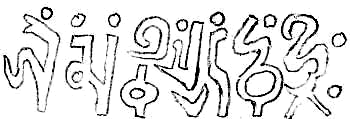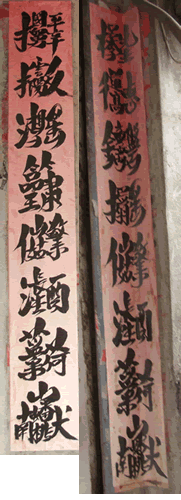These puzzles were sent in by a visitor to Omniglot from Taiwan. The first appears on a mosquito coil and looks a bit like Tibetan or one of the other Brahmi-derived scripts.

These characters were spotted in Lugang (鹿港).

Can you make any sense of the writing in either of these images?
For the second one I’d guess Tangut.
The first might be an illiterate fantasy based on the Avalokitesvara mantra, possibly from a Lantsa script version. The first two signs are consistent with “oṃ ma” and the final one has the rough look of “hūṃ”.
the characters definitely have Chinese component shapes (for example, box shapes) that you don’t find in Tangut. I wonder if they belong to a special genre of script…
To me, I think the first and second shapes (from the left), have something common with some brahmi scripts.
Question off the topic:
In Omniglot and other places, I encounter these letters in boxes with their Unicode inside them. How to show these letters are they are?
TJ – you probably get the boxes rather than letters because you don’t have the necessary fonts installed on your computer. A good place to find unicode fonts is http://www.wazu.jp
Weird — my first comment doesn’t appear here, though I thought I saw it before. In the Indian script example, the first letter looks like a ‘j’, the second like ‘m’ in an early Nāgari script from a time before the modern Devanāgari head stroke became stabilised: the ‘j’ shape is one that the modern shapes in Devanagari, Kaithi (shown in the Bhojpuri article), Syloti/Sylheti Nāgari and eventually Gujarati scripts all directly developed from. Faulmann’s Das Buch der Schrift shoes an old Devanāgari typeface with almost exactly this shape for ‘j’.
As for the rest of the letters, they’re too fragmented in this sample to make out, though I’d agree with Dennis King that the last one could possibly be ‘h’.
As to the Chinese “characters”, my friend says that it IS actually Chinese, but each “character” is actually a whole word or phrase made into one “character”. It is an artistic form. You can call it 合字, but that just means “ligature”, like is common in older styles of written German. The most common Chinese 合字 is 招財進寶, which is very common for Lunar New Year. You can see all four character’s making up the 合字.
See Wikipedia’s picture.
http://zh.wikipedia.org/zh-tw/File:Chinese_Character_zhao1_cai2_jin4_bao3.png
Returning to the picture provided above, my friend and his father can’t recognize all the 合字 (they say it’s sloppy 😉 but some are quite obvious. The third one from the bottom on the left for example is 長生酒. It means something like the wine of long life. The second one from the bottom is probably the name of one fairy from the story “8 fairies cross the sea”, 八先過海, however my friend and his dad feel the artist here made a mistake. His name should be 藍采和, but the artist wrote for the last character 荷. Other fairis’ names are also visible in some of the 合字. In the first 合字 the last two parts of 曹國舅 are visible. In the third 合字 again the last two parts of 韓湘子 are seen. And in the fifth 合字 again the last two characters of 何仙姑 are seen. The only other one that my friend and his dad could see is 鐵拐李 in the first 合字 on the right side. The other fairies are 呂洞賓、張果老、漢鍾離, but maybe they are written differently, or are for some reason not mentioned by name. Also the bottom four 合字 on the left are repeated on the bottom of the right. Another point: the fourth 合字 down on the left side contains the character for 簫, a musial instrument, which is the symbol for 韓湘子 (the fairy mentioned in the 合字 left-side 3rd down).
So…. it almost certainly has something to do with this story, but beyond this my friend and his dad can’t be of much more help.
Sorry, for the disorganization of it all! 😉
What does _zhao1 cai2 jin4 bao3_ mean?
Qcumber – zhao1 cai2 jin4 bao3 (招財進寶) means “We wish you wealth and success” and is a traditional greeting used especially at Chinese New Year.
Thanks a lot, Simon.